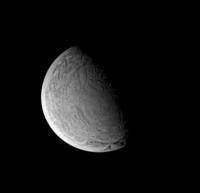What Cassini heard from Huygens as it descended to Titan’s surface is now available as an audio file from the European Space Agency, but it may be easier to download it from Ralph Lorenz’ home page. Lorenz is an assistant research scientist at the University of Arizona’s Lunar and Planetary Laboratory and a co-investigator on Huygens’ Surface Science Package; he created the sound file based on Cassini data. The file compresses four hours of real-time audio into about a minute.
What the listener hears is a tone whose frequency depends on the strength of the Huygens signal as received by Cassini. The probe’s antenna emitted radio energy unevenly, “…like the petals of a flower rather than the smooth shape of a fruit,” as Lorenz puts it. As the probe’s orientation changed durings its long descent, its spin rate slowed, causing rapid changes in the tone. “You can hear how the motion becomes slower and steadier later in the descent,” Lorenz said. A UA press release on Lorenz’ work can be found here.
Meanwhile, the 2005 AAAS meeting opens February 17 in Washington, DC. The American Association for the Advancement of Science is the world’s largest scientific society, with 262 affiliated societies serving over ten million people, more than 10,000 of whom are expected at the Washington meeting. Among them will be Steven W. Squyres, who will present the latest from the Mars rovers, and mission scientists from JPL who will offer further updates on Cassini. The meeting opens just a few days after today’s Titan flyby (Cassini’s fourth), with an Enceladus encounter on the horizon for the 17th. The latter should be interesting; Enceladus reflects more than 90 percent of arriving sunlight, and is the most reflective body in the Solar System.
 Image: This Cassini image of Saturn’s moon Enceladus shows a region containing bizarre, wrinkled terrain. Enceladus is covered with bright water ice. The part of its surface visible here appears to be largely free of craters — indicating that it is geologically young.
Image: This Cassini image of Saturn’s moon Enceladus shows a region containing bizarre, wrinkled terrain. Enceladus is covered with bright water ice. The part of its surface visible here appears to be largely free of craters — indicating that it is geologically young.
The first close imaging of this moon will be done by Cassini in February 2005 and should reveal many surprises. Enceladus has a diameter of 499 kilometers (310 miles). Credit: NASA/JPL/Space Science Institute.
You may remember that Enceladus was at one point to be the destination for Project Orion, back in the halcyon days when the mammoth nuclear rocket looked like it might become a reality. Orion was designed for huge payloads; Freeman Dyson even pondered Project Deluge, a plan for bringing water from Enceladus (where it is plentiful) to Mars via the Orion craft. For more on this, see George Dyson’s wonderful Project Orion: The True Story of the Atomic Spaceship (New York: Henry Holt, 2002). Anyone with an interest in interstellar issues should have Dyson’s book on their shelves.

